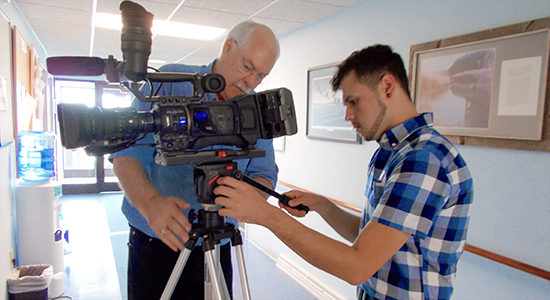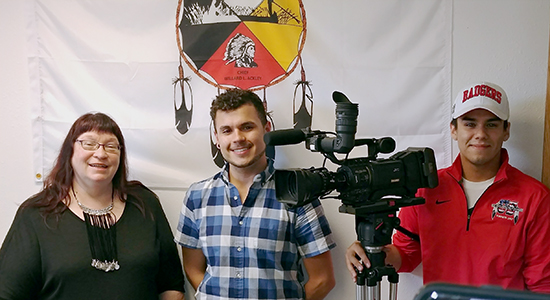
Now-retired State Bar Production Manager Dennis Pince demonstrates use of the video camera to Adam VanZile of the Sokaogon Chippewa Community.
July 19, 2017 – Storytelling is in our culture, says Adam VanZile of the Sokaogan Chippewa Community, the Mole Lake Band of Lake Superior Chippewa Indians.
Preserving the Sokaogan Chippewa Community’s culture, language, and storytelling traditions just got easier, following the State Bar of Wisconsin’s donation of video equipment to the tribe.
Our elders’ stories aren’t written down, said VanZile, the tribe’s historic preservation officer. And, as time goes on, we risk losing those stories.
Forging Community Connections
State Bar Media Production Manager Dennis Pince, anticipating his retirement July 7, upgraded the aging video equipment used to record PINNACLE® seminars.
“While our video equipment needs to keep pace with new recording and delivery technologies, there is still good life in this equipment,” Pince says of the cameras and video mixing consoles. “I didn’t want the retired equipment to just gather dust in a closet.”
Through connections with co-workers, Pince located two new homes for the equipment: the Sokaogon Chippewa Community Tribal Historic Preservation Office and Ray F. Sennett Middle School in Madison.

State Bar Administration Coordinator Beth Drake poses with Adam VanZile and Ray Tallier of the Sokaogon Chippewa Community.
‘Storytelling is Part of Our Culture’
Pince connected with the Sokaogon Chippewa Community through co-worker Beth Drake, a Member Services Department administrative coordinator. Through her connections with the tribe, the offer was enthusiastically accepted.
Most Native American tribes do not have a written language, and their history, spiritual beliefs, and traditions are passed down through stories and teachings from elders. "With fewer fluent speakers passing on these teachings," Drake said, "many tribes are losing their languages."
On July 5 – two days before Pince retired – he and Drake delivered the equipment to Mole Lake in Forest County, east of Rhinelander. While there, Pince trained VanZile how to operate the cameras and other equipment.
VanZile is already putting the equipment to good use. "It's a wonderful opportunity for tribal members to come and interview elders and others, and share their stories for future generations," VanZile said.
“Storytelling is part of our culture,” he said. “Recording these stories will allow a younger tribal members to see their great-great grandfathers telling their stories.”
VanZile and his staff will go into the homes to video record elders and fluent language speakers, to preserve their language and stories for the generations to come. The equipment will also be used with ground-penetrating radar to provide maps of the tribe's historic cemetery at Mole Lake.
More Information
For more information on the donation to the Sokaogan Chippewa Community, see:
The Sennett News Network
In late May, Barbara Moddes, a program planner in the Professional Development Department, introduced Pince to Mika Oriedo, a teacher at Ray F. Sennett Middle School on Madison’s east side, who she knows through a family connection. Could the school use a camera, a video mixer, and tripods? she asked Oriedo. He enthusiastically said “Yes.”
“This is primo stuff for its era, definitely much better than what we had,” Oriedo said.
Each morning, students give live announcements on video – called SNN, or the Sennett News Network. “We get our updates, do the Pledge of Allegiance,” Oriedo said. Except their video camera, he said, was “on its last leg” – and the district could not afford to purchase new equipment.
“The students are very excited about using the equipment,” he said. “It’s going to allow us to explore video in a way we couldn’t have without it.”
